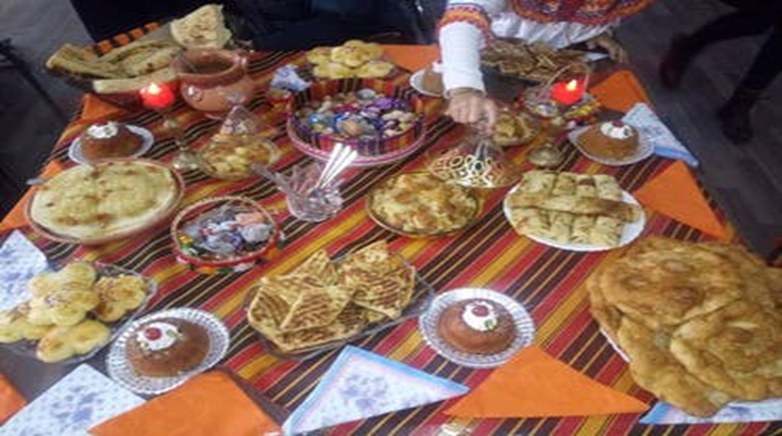. This is how the Amazighs of North Africa celebrate New Year

The Amazigh New Year celebrations of North Africa begin on Saturday, which are celebrated annually with special rituals, customs and traditions that differ from one country to another, but they all reflect the identity of the Amazigh, their culture and heritage in the region, and are dominated by social solidarity, solidarity, and holding and sharing banquets among everyone.
The Amazigh celebrate the arrival of the New Year, 2974, on January 12, which is a calendar based on nature and climate, as this day represents a time and climatic interval between two periods, the period of extreme cold and the period of moderation. It is also considered the beginning of the agricultural year, and from here came the name of the Amazigh New Year as the New Year of the Agricultural Year. It is an event that has great symbolism for the Amazigh, the majority of whom depend on agriculture.
Accordingly, Amazigh families still celebrate this occasion in all Amazigh regions of North Africa, from Morocco to Libya, with a traditional heritage character, by preparing their own dishes and distinctive banquets, in addition to organizing cultural and musical events to revive some well-known Amazigh traditions that are different between each region. And another and trying to define it.

Porridge, molokhiya, and the Amazigh connection to the land
In Tunisia, where the Amazigh population represents only 5 percent of the country’s population, Amazigh activist Nouri Al-Nimri confirmed that “the Amazigh are still loyal to their inherited customs and traditions, as their New Year’s tables are not without a dish of “porridge” of various types and tastes, especially in rural areas. It is a dish that symbolizes synergy, solidarity, and cohesion because all family members share its food in one common bowl,” he added, adding that “urban areas prepare the molokhiya dish so that the year is green,” explaining to Al Arabiya.net that “Berber food in general reflects a connection between "The Amazigh person is strong in his land."
In Algeria, where the Amazighs Amazigh speakers of the Amazigh language represent about a third of the population, women compete every year to cook delicious Amazigh popular cuisine, due to the belief in Amazigh culture that the diversity of dishes suggests abundant livelihood and opens the door to many profits and reaping an abundant harvest during the New Year.
“January 12 is our Amazigh day. The customs of celebrating it differ from one region to another, but they are similar in their connotations and symbolism,” said Amazigh activist Jamal Moez from Bouira Governorate

Slaughter the rooster and protect the family from envy
Moez added that the Kabylie region, which has an Amazigh majority, is famous for preparing a couscous dish, after a turkey or chicken is slaughtered in front of the family home, in the firm belief that this will protect the family from the evil eye, protect it from dangers and diseases throughout the year, in addition to... Sweets, tea and fruits,” indicating that this occasion also witnesses the organization of some wedding and engagement parties and circumcision as well, out of optimism for the month that many view as a symbol of fertility and bliss.
He continued, pointing out that the most prominent feature of the Amazigh New Year celebrations in Algeria is “solidarity and interdependence between families, as some villages in the Kabylie region still maintain the revival of the “Wazia” custom, which brings together all the villagers, women, men and children, in one place where sheep are slaughtered. And distribute it in the form of shares without discrimination between the poor and the rich, so that God blesses the new agricultural year and the crops are abundant for everyone.”
In western Algeria, the celebration lies in the housewives preparing “couscous” with chicken and eggs, while in the city of Ghardaia in southern Algeria, women work on preparing the “rfis” dish, which is a traditional sugary dish that is required to be used only with white materials such as sugar, semolina, and milk, so that it is Sunnah. The new city, according to what is well-established in people's minds, is full of peace and prosperity.

Abstaining from eating meat in Morocco
Unlike Algeria, the Amazighs of Morocco abstain from eating meat on the Amazigh New Year, and the focus is mainly on preparing what the Amazighs call “takla”, or porridge, or preparing the dish “couscous with seven vegetables”, and the aim of this is to participate in nature in its new birth and rejoice in the arrival of an agricultural year. New, in addition to preparing types of sweets, pies, local food, and dishes made of dry fruits, including in particular (almonds, walnuts, figs, raisins, cocoa, and wheat), as an expression of the Amazigh connection to the land.
In Libya, due to war conditions and the separation of families, the Amazigh stopped celebrating the Amazigh New Year.

The celebration of the Amazigh New Year in the North African region remains a tradition passed down through generations, an opportunity for social unity, and a unified occasion for heritage and cultural celebrations, attracting in some areas local or international tourists to see and learn about the Amazigh tangible and intangible heritage, the “Isqas Amqas” for all Amazighs.
Source : websites

